Assessing the Total Economic Value of the Great Barrier Reef
VerifiedAdded on 2023/06/05
|13
|3753
|129
AI Summary
This essay deals with the need of conserving the GBR, the advantages and the ecological economy of conservation of the Reef. The social costs and benefits of conserving the GBR are discussed and tabulated. A Total Economic Value framework is made on the GBR, and its components are analysed. The Sustainable Development Appraisal and the trans-disciplinary approach is discussed, in relation to the ecological economics of the conservation of the GBR. Various environmental valuation techniques are discussed, and the most efficient of them is analysed. The best suited framework wherein the environmental valuation results could be presented to support decision making regarding the conservation of the GBR is suggested.
Contribute Materials
Your contribution can guide someone’s learning journey. Share your
documents today.
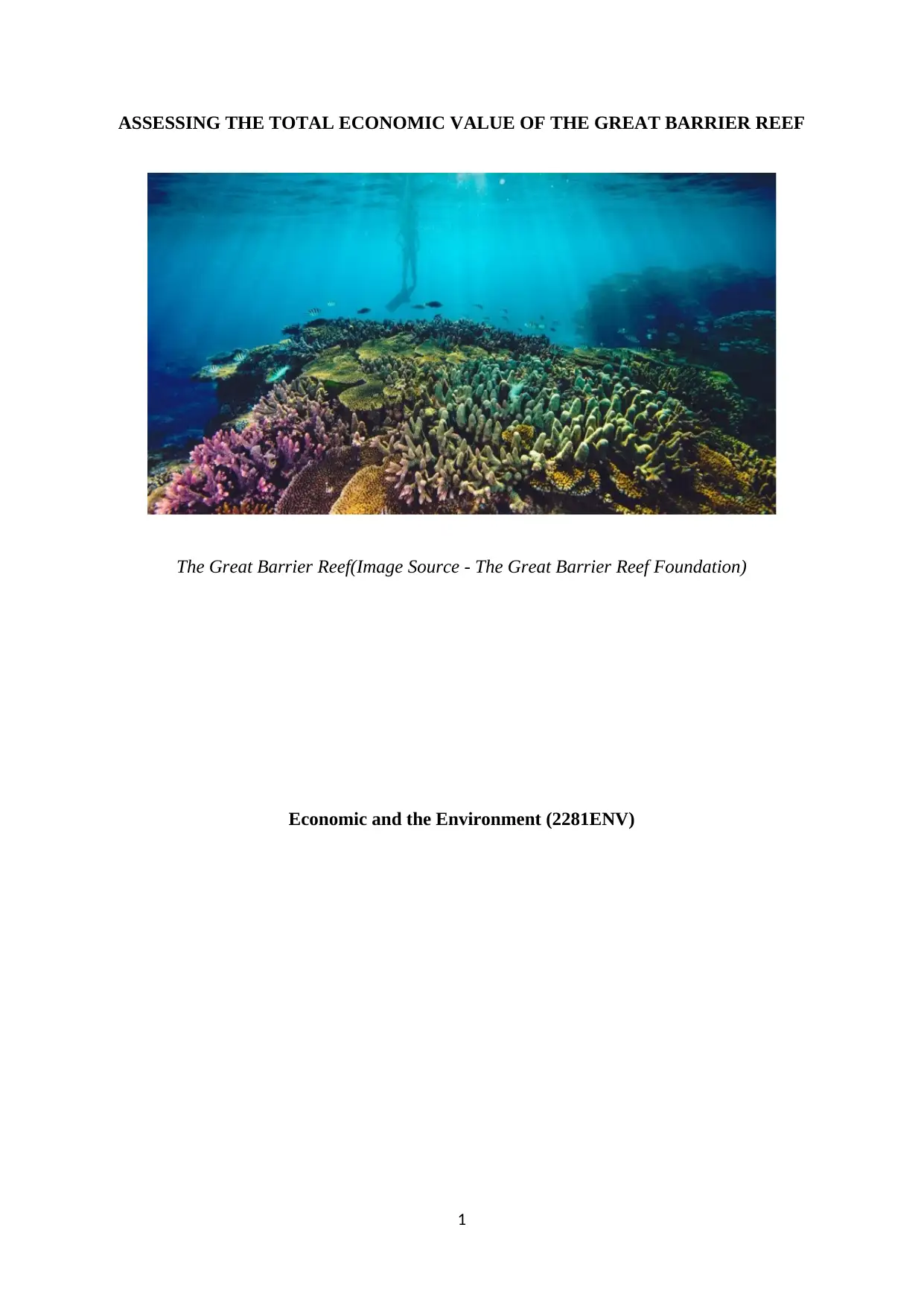
ASSESSING THE TOTAL ECONOMIC VALUE OF THE GREAT BARRIER REEF
The Great Barrier Reef(Image Source - The Great Barrier Reef Foundation)
Economic and the Environment (2281ENV)
1
The Great Barrier Reef(Image Source - The Great Barrier Reef Foundation)
Economic and the Environment (2281ENV)
1
Secure Best Marks with AI Grader
Need help grading? Try our AI Grader for instant feedback on your assignments.
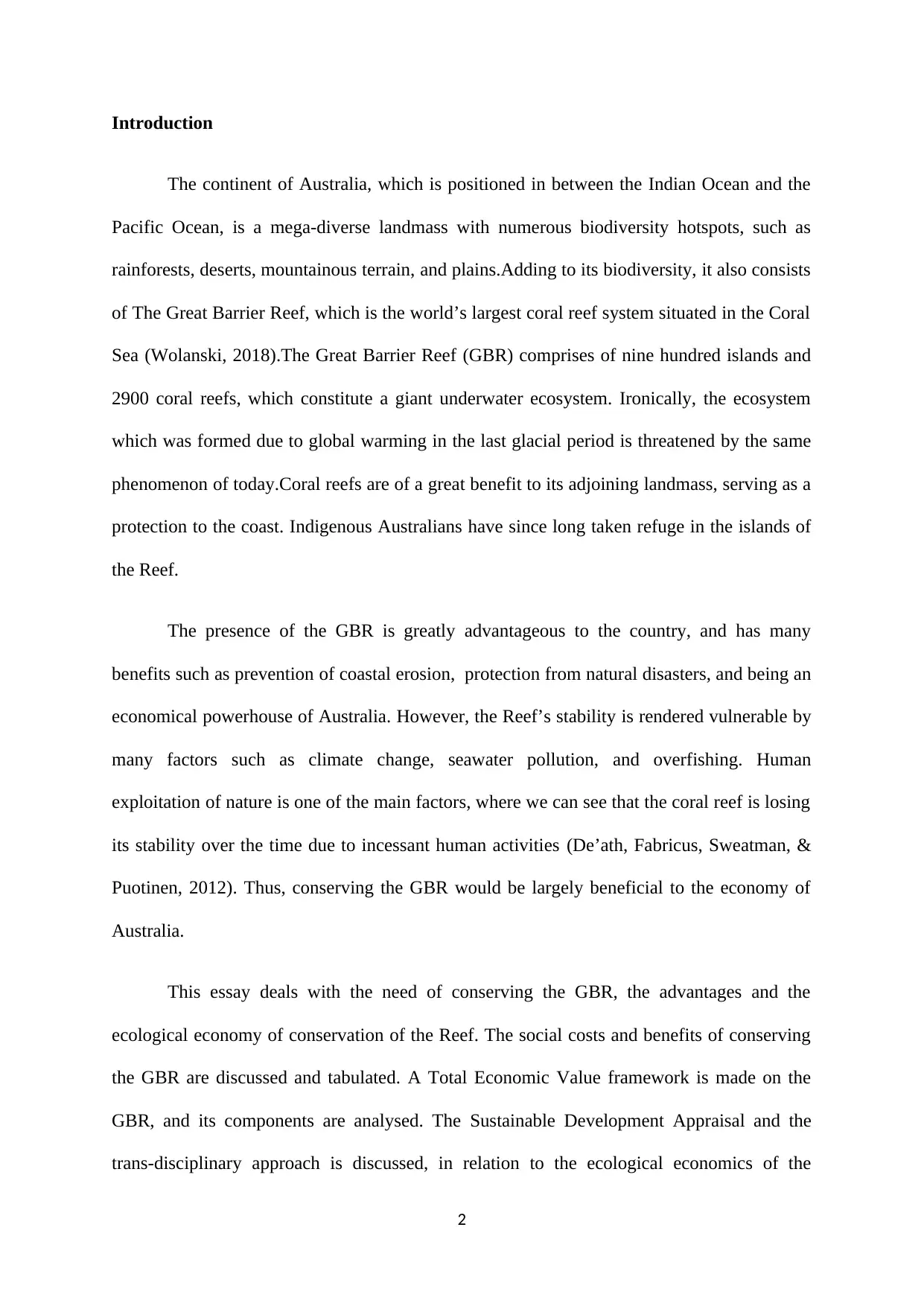
Introduction
The continent of Australia, which is positioned in between the Indian Ocean and the
Pacific Ocean, is a mega-diverse landmass with numerous biodiversity hotspots, such as
rainforests, deserts, mountainous terrain, and plains.Adding to its biodiversity, it also consists
of The Great Barrier Reef, which is the world’s largest coral reef system situated in the Coral
Sea (Wolanski, 2018).The Great Barrier Reef (GBR) comprises of nine hundred islands and
2900 coral reefs, which constitute a giant underwater ecosystem. Ironically, the ecosystem
which was formed due to global warming in the last glacial period is threatened by the same
phenomenon of today.Coral reefs are of a great benefit to its adjoining landmass, serving as a
protection to the coast. Indigenous Australians have since long taken refuge in the islands of
the Reef.
The presence of the GBR is greatly advantageous to the country, and has many
benefits such as prevention of coastal erosion, protection from natural disasters, and being an
economical powerhouse of Australia. However, the Reef’s stability is rendered vulnerable by
many factors such as climate change, seawater pollution, and overfishing. Human
exploitation of nature is one of the main factors, where we can see that the coral reef is losing
its stability over the time due to incessant human activities (De’ath, Fabricus, Sweatman, &
Puotinen, 2012). Thus, conserving the GBR would be largely beneficial to the economy of
Australia.
This essay deals with the need of conserving the GBR, the advantages and the
ecological economy of conservation of the Reef. The social costs and benefits of conserving
the GBR are discussed and tabulated. A Total Economic Value framework is made on the
GBR, and its components are analysed. The Sustainable Development Appraisal and the
trans-disciplinary approach is discussed, in relation to the ecological economics of the
2
The continent of Australia, which is positioned in between the Indian Ocean and the
Pacific Ocean, is a mega-diverse landmass with numerous biodiversity hotspots, such as
rainforests, deserts, mountainous terrain, and plains.Adding to its biodiversity, it also consists
of The Great Barrier Reef, which is the world’s largest coral reef system situated in the Coral
Sea (Wolanski, 2018).The Great Barrier Reef (GBR) comprises of nine hundred islands and
2900 coral reefs, which constitute a giant underwater ecosystem. Ironically, the ecosystem
which was formed due to global warming in the last glacial period is threatened by the same
phenomenon of today.Coral reefs are of a great benefit to its adjoining landmass, serving as a
protection to the coast. Indigenous Australians have since long taken refuge in the islands of
the Reef.
The presence of the GBR is greatly advantageous to the country, and has many
benefits such as prevention of coastal erosion, protection from natural disasters, and being an
economical powerhouse of Australia. However, the Reef’s stability is rendered vulnerable by
many factors such as climate change, seawater pollution, and overfishing. Human
exploitation of nature is one of the main factors, where we can see that the coral reef is losing
its stability over the time due to incessant human activities (De’ath, Fabricus, Sweatman, &
Puotinen, 2012). Thus, conserving the GBR would be largely beneficial to the economy of
Australia.
This essay deals with the need of conserving the GBR, the advantages and the
ecological economy of conservation of the Reef. The social costs and benefits of conserving
the GBR are discussed and tabulated. A Total Economic Value framework is made on the
GBR, and its components are analysed. The Sustainable Development Appraisal and the
trans-disciplinary approach is discussed, in relation to the ecological economics of the
2

conservation of the GBR. Various environmental valuation techniques are discussed, and the
most efficient of them is analysed. The best suited framework wherin the environmental
valuation results could be presented to support decision making regarding the conservation of
the GBR is suggested. This essay provides a theoretical perspective to analyzing the
ecological economics of the GBR, which can be used to calculate the actual monetary value
of the costs and benefits of its conservation.
What are the Social Benefits and Costs of Conserving the GBR?
The Costs-Benefit analysis is a systematic approach which is used to calcualte,
compare, and analyze the costs and benefits of a given action or a situation (Ding, 2008).It is
highly beneficial in determining the suitable option which provides equitable benefits to the
costs incurred, thus is highly effective in calculating opportunity costs. While assessing the
the costs and benefits in the conservation of the GBR, there are a lot of factors that must be
considered, which are detailed in Table 1 and 2.
3
most efficient of them is analysed. The best suited framework wherin the environmental
valuation results could be presented to support decision making regarding the conservation of
the GBR is suggested. This essay provides a theoretical perspective to analyzing the
ecological economics of the GBR, which can be used to calculate the actual monetary value
of the costs and benefits of its conservation.
What are the Social Benefits and Costs of Conserving the GBR?
The Costs-Benefit analysis is a systematic approach which is used to calcualte,
compare, and analyze the costs and benefits of a given action or a situation (Ding, 2008).It is
highly beneficial in determining the suitable option which provides equitable benefits to the
costs incurred, thus is highly effective in calculating opportunity costs. While assessing the
the costs and benefits in the conservation of the GBR, there are a lot of factors that must be
considered, which are detailed in Table 1 and 2.
3
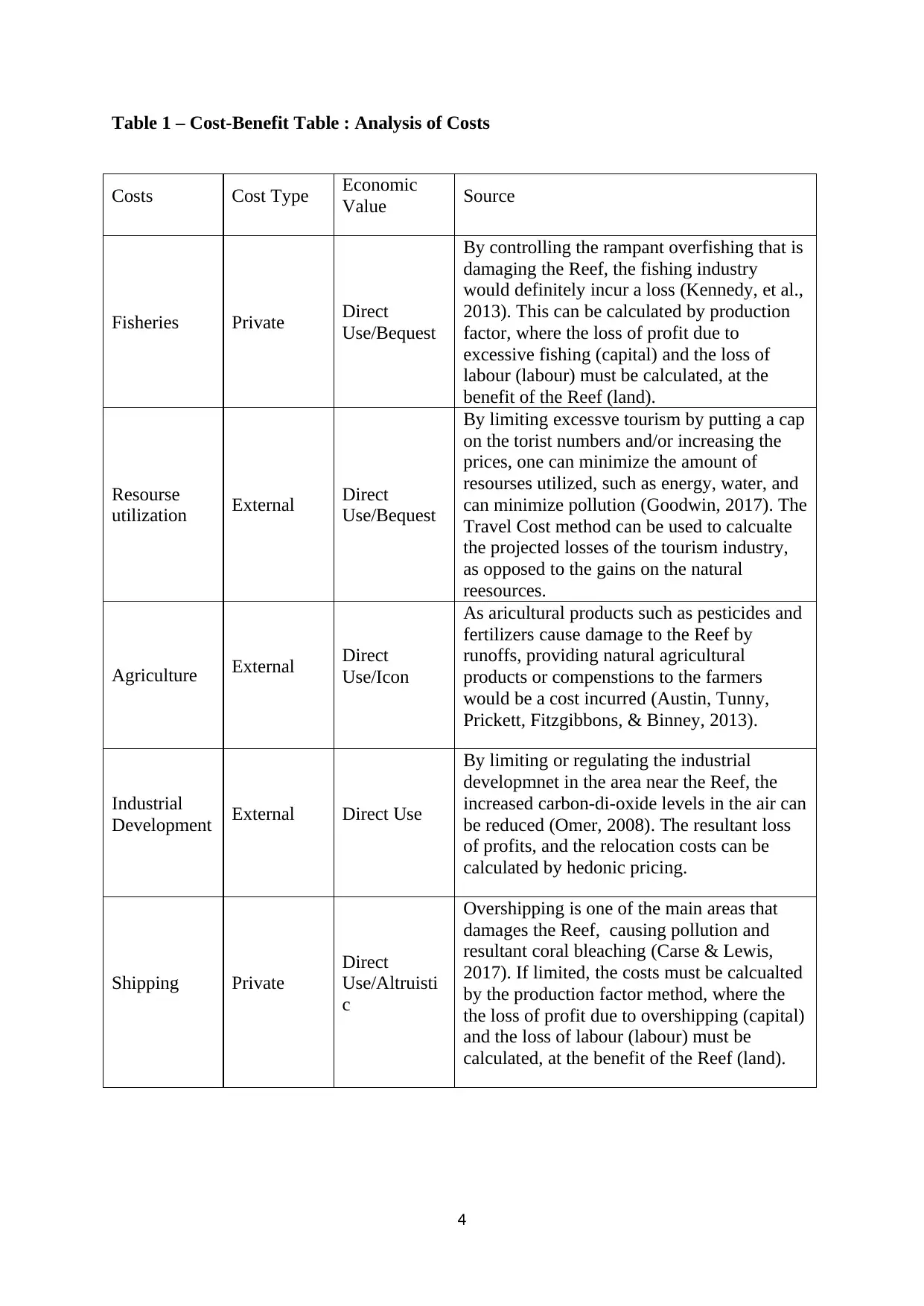
Table 1 – Cost-Benefit Table : Analysis of Costs
Costs Cost Type Economic
Value Source
Fisheries Private Direct
Use/Bequest
By controlling the rampant overfishing that is
damaging the Reef, the fishing industry
would definitely incur a loss (Kennedy, et al.,
2013). This can be calculated by production
factor, where the loss of profit due to
excessive fishing (capital) and the loss of
labour (labour) must be calculated, at the
benefit of the Reef (land).
Resourse
utilization External Direct
Use/Bequest
By limiting excessve tourism by putting a cap
on the torist numbers and/or increasing the
prices, one can minimize the amount of
resourses utilized, such as energy, water, and
can minimize pollution (Goodwin, 2017). The
Travel Cost method can be used to calcualte
the projected losses of the tourism industry,
as opposed to the gains on the natural
reesources.
Agriculture External Direct
Use/Icon
As aricultural products such as pesticides and
fertilizers cause damage to the Reef by
runoffs, providing natural agricultural
products or compenstions to the farmers
would be a cost incurred (Austin, Tunny,
Prickett, Fitzgibbons, & Binney, 2013).
Industrial
Development External Direct Use
By limiting or regulating the industrial
developmnet in the area near the Reef, the
increased carbon-di-oxide levels in the air can
be reduced (Omer, 2008). The resultant loss
of profits, and the relocation costs can be
calculated by hedonic pricing.
Shipping Private
Direct
Use/Altruisti
c
Overshipping is one of the main areas that
damages the Reef, causing pollution and
resultant coral bleaching (Carse & Lewis,
2017). If limited, the costs must be calcualted
by the production factor method, where the
the loss of profit due to overshipping (capital)
and the loss of labour (labour) must be
calculated, at the benefit of the Reef (land).
4
Costs Cost Type Economic
Value Source
Fisheries Private Direct
Use/Bequest
By controlling the rampant overfishing that is
damaging the Reef, the fishing industry
would definitely incur a loss (Kennedy, et al.,
2013). This can be calculated by production
factor, where the loss of profit due to
excessive fishing (capital) and the loss of
labour (labour) must be calculated, at the
benefit of the Reef (land).
Resourse
utilization External Direct
Use/Bequest
By limiting excessve tourism by putting a cap
on the torist numbers and/or increasing the
prices, one can minimize the amount of
resourses utilized, such as energy, water, and
can minimize pollution (Goodwin, 2017). The
Travel Cost method can be used to calcualte
the projected losses of the tourism industry,
as opposed to the gains on the natural
reesources.
Agriculture External Direct
Use/Icon
As aricultural products such as pesticides and
fertilizers cause damage to the Reef by
runoffs, providing natural agricultural
products or compenstions to the farmers
would be a cost incurred (Austin, Tunny,
Prickett, Fitzgibbons, & Binney, 2013).
Industrial
Development External Direct Use
By limiting or regulating the industrial
developmnet in the area near the Reef, the
increased carbon-di-oxide levels in the air can
be reduced (Omer, 2008). The resultant loss
of profits, and the relocation costs can be
calculated by hedonic pricing.
Shipping Private
Direct
Use/Altruisti
c
Overshipping is one of the main areas that
damages the Reef, causing pollution and
resultant coral bleaching (Carse & Lewis,
2017). If limited, the costs must be calcualted
by the production factor method, where the
the loss of profit due to overshipping (capital)
and the loss of labour (labour) must be
calculated, at the benefit of the Reef (land).
4
Secure Best Marks with AI Grader
Need help grading? Try our AI Grader for instant feedback on your assignments.
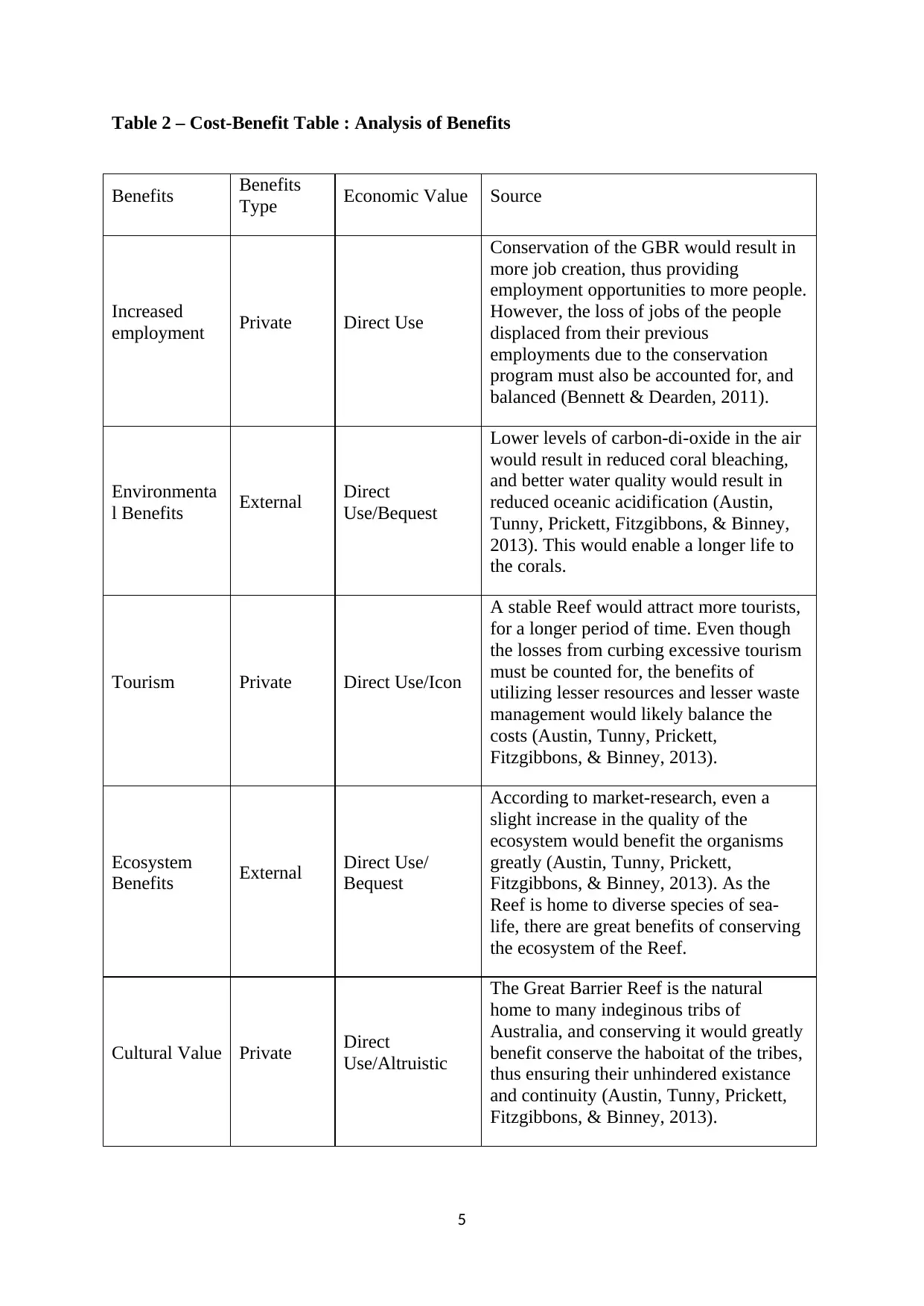
Table 2 – Cost-Benefit Table : Analysis of Benefits
Benefits Benefits
Type Economic Value Source
Increased
employment Private Direct Use
Conservation of the GBR would result in
more job creation, thus providing
employment opportunities to more people.
However, the loss of jobs of the people
displaced from their previous
employments due to the conservation
program must also be accounted for, and
balanced (Bennett & Dearden, 2011).
Environmenta
l Benefits External Direct
Use/Bequest
Lower levels of carbon-di-oxide in the air
would result in reduced coral bleaching,
and better water quality would result in
reduced oceanic acidification (Austin,
Tunny, Prickett, Fitzgibbons, & Binney,
2013). This would enable a longer life to
the corals.
Tourism Private Direct Use/Icon
A stable Reef would attract more tourists,
for a longer period of time. Even though
the losses from curbing excessive tourism
must be counted for, the benefits of
utilizing lesser resources and lesser waste
management would likely balance the
costs (Austin, Tunny, Prickett,
Fitzgibbons, & Binney, 2013).
Ecosystem
Benefits External Direct Use/
Bequest
According to market-research, even a
slight increase in the quality of the
ecosystem would benefit the organisms
greatly (Austin, Tunny, Prickett,
Fitzgibbons, & Binney, 2013). As the
Reef is home to diverse species of sea-
life, there are great benefits of conserving
the ecosystem of the Reef.
Cultural Value Private Direct
Use/Altruistic
The Great Barrier Reef is the natural
home to many indeginous tribs of
Australia, and conserving it would greatly
benefit conserve the haboitat of the tribes,
thus ensuring their unhindered existance
and continuity (Austin, Tunny, Prickett,
Fitzgibbons, & Binney, 2013).
5
Benefits Benefits
Type Economic Value Source
Increased
employment Private Direct Use
Conservation of the GBR would result in
more job creation, thus providing
employment opportunities to more people.
However, the loss of jobs of the people
displaced from their previous
employments due to the conservation
program must also be accounted for, and
balanced (Bennett & Dearden, 2011).
Environmenta
l Benefits External Direct
Use/Bequest
Lower levels of carbon-di-oxide in the air
would result in reduced coral bleaching,
and better water quality would result in
reduced oceanic acidification (Austin,
Tunny, Prickett, Fitzgibbons, & Binney,
2013). This would enable a longer life to
the corals.
Tourism Private Direct Use/Icon
A stable Reef would attract more tourists,
for a longer period of time. Even though
the losses from curbing excessive tourism
must be counted for, the benefits of
utilizing lesser resources and lesser waste
management would likely balance the
costs (Austin, Tunny, Prickett,
Fitzgibbons, & Binney, 2013).
Ecosystem
Benefits External Direct Use/
Bequest
According to market-research, even a
slight increase in the quality of the
ecosystem would benefit the organisms
greatly (Austin, Tunny, Prickett,
Fitzgibbons, & Binney, 2013). As the
Reef is home to diverse species of sea-
life, there are great benefits of conserving
the ecosystem of the Reef.
Cultural Value Private Direct
Use/Altruistic
The Great Barrier Reef is the natural
home to many indeginous tribs of
Australia, and conserving it would greatly
benefit conserve the haboitat of the tribes,
thus ensuring their unhindered existance
and continuity (Austin, Tunny, Prickett,
Fitzgibbons, & Binney, 2013).
5
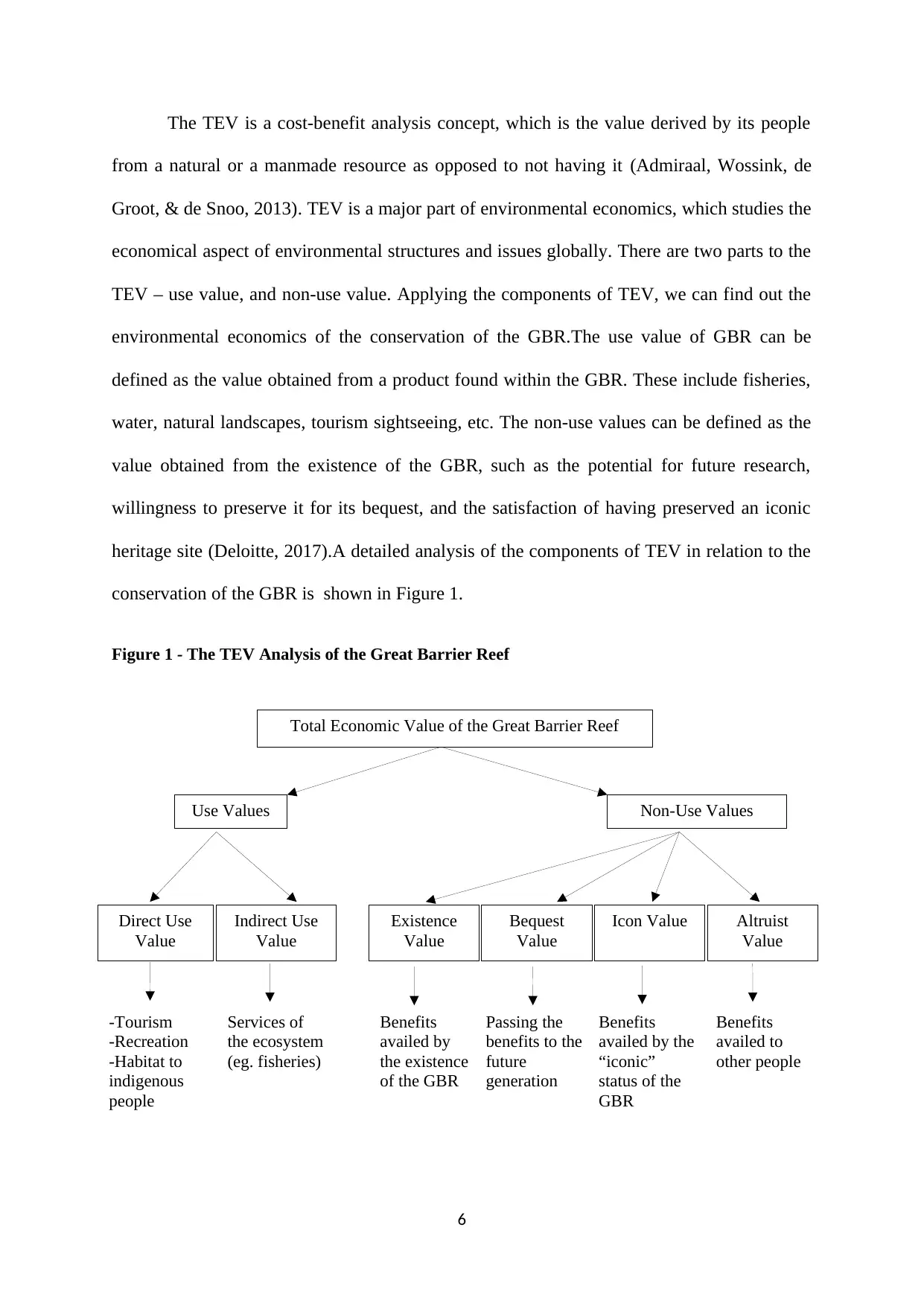
Total Economic Value of the Great Barrier Reef
Use Values Non-Use Values
Direct Use
Value
Indirect Use
Value
Existence
Value
Bequest
Value
Icon Value Altruist
Value
-Tourism
-Recreation
-Habitat to
indigenous
people
Services of
the ecosystem
(eg. fisheries)
Benefits
availed by
the existence
of the GBR
Passing the
benefits to the
future
generation
Benefits
availed by the
“iconic”
status of the
GBR
Benefits
availed to
other people
The TEV is a cost-benefit analysis concept, which is the value derived by its people
from a natural or a manmade resource as opposed to not having it (Admiraal, Wossink, de
Groot, & de Snoo, 2013). TEV is a major part of environmental economics, which studies the
economical aspect of environmental structures and issues globally. There are two parts to the
TEV – use value, and non-use value. Applying the components of TEV, we can find out the
environmental economics of the conservation of the GBR.The use value of GBR can be
defined as the value obtained from a product found within the GBR. These include fisheries,
water, natural landscapes, tourism sightseeing, etc. The non-use values can be defined as the
value obtained from the existence of the GBR, such as the potential for future research,
willingness to preserve it for its bequest, and the satisfaction of having preserved an iconic
heritage site (Deloitte, 2017).A detailed analysis of the components of TEV in relation to the
conservation of the GBR is shown in Figure 1.
Figure 1 - The TEV Analysis of the Great Barrier Reef
6
Use Values Non-Use Values
Direct Use
Value
Indirect Use
Value
Existence
Value
Bequest
Value
Icon Value Altruist
Value
-Tourism
-Recreation
-Habitat to
indigenous
people
Services of
the ecosystem
(eg. fisheries)
Benefits
availed by
the existence
of the GBR
Passing the
benefits to the
future
generation
Benefits
availed by the
“iconic”
status of the
GBR
Benefits
availed to
other people
The TEV is a cost-benefit analysis concept, which is the value derived by its people
from a natural or a manmade resource as opposed to not having it (Admiraal, Wossink, de
Groot, & de Snoo, 2013). TEV is a major part of environmental economics, which studies the
economical aspect of environmental structures and issues globally. There are two parts to the
TEV – use value, and non-use value. Applying the components of TEV, we can find out the
environmental economics of the conservation of the GBR.The use value of GBR can be
defined as the value obtained from a product found within the GBR. These include fisheries,
water, natural landscapes, tourism sightseeing, etc. The non-use values can be defined as the
value obtained from the existence of the GBR, such as the potential for future research,
willingness to preserve it for its bequest, and the satisfaction of having preserved an iconic
heritage site (Deloitte, 2017).A detailed analysis of the components of TEV in relation to the
conservation of the GBR is shown in Figure 1.
Figure 1 - The TEV Analysis of the Great Barrier Reef
6
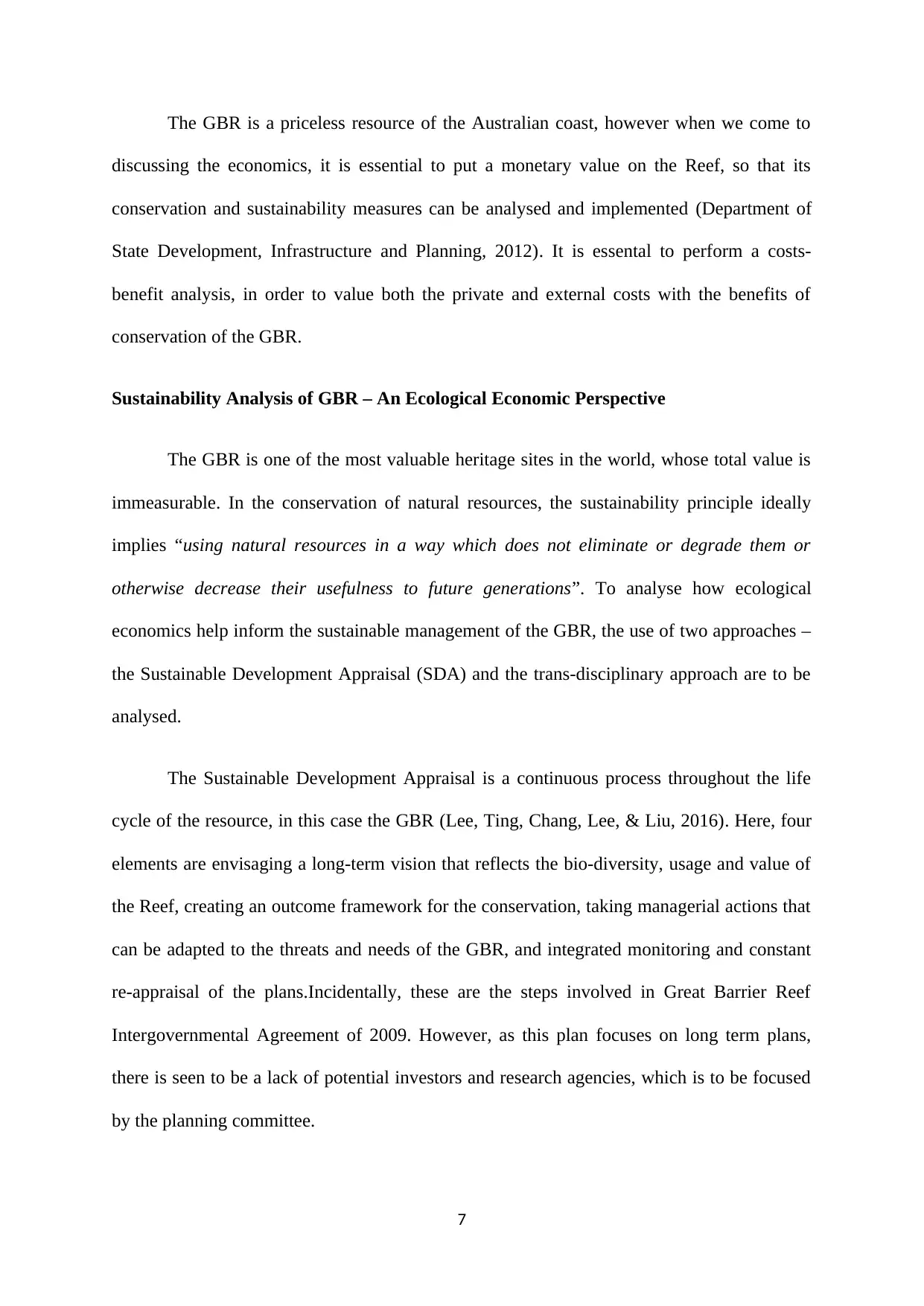
The GBR is a priceless resource of the Australian coast, however when we come to
discussing the economics, it is essential to put a monetary value on the Reef, so that its
conservation and sustainability measures can be analysed and implemented (Department of
State Development, Infrastructure and Planning, 2012). It is essental to perform a costs-
benefit analysis, in order to value both the private and external costs with the benefits of
conservation of the GBR.
Sustainability Analysis of GBR – An Ecological Economic Perspective
The GBR is one of the most valuable heritage sites in the world, whose total value is
immeasurable. In the conservation of natural resources, the sustainability principle ideally
implies “using natural resources in a way which does not eliminate or degrade them or
otherwise decrease their usefulness to future generations”. To analyse how ecological
economics help inform the sustainable management of the GBR, the use of two approaches –
the Sustainable Development Appraisal (SDA) and the trans-disciplinary approach are to be
analysed.
The Sustainable Development Appraisal is a continuous process throughout the life
cycle of the resource, in this case the GBR (Lee, Ting, Chang, Lee, & Liu, 2016). Here, four
elements are envisaging a long-term vision that reflects the bio-diversity, usage and value of
the Reef, creating an outcome framework for the conservation, taking managerial actions that
can be adapted to the threats and needs of the GBR, and integrated monitoring and constant
re-appraisal of the plans.Incidentally, these are the steps involved in Great Barrier Reef
Intergovernmental Agreement of 2009. However, as this plan focuses on long term plans,
there is seen to be a lack of potential investors and research agencies, which is to be focused
by the planning committee.
7
discussing the economics, it is essential to put a monetary value on the Reef, so that its
conservation and sustainability measures can be analysed and implemented (Department of
State Development, Infrastructure and Planning, 2012). It is essental to perform a costs-
benefit analysis, in order to value both the private and external costs with the benefits of
conservation of the GBR.
Sustainability Analysis of GBR – An Ecological Economic Perspective
The GBR is one of the most valuable heritage sites in the world, whose total value is
immeasurable. In the conservation of natural resources, the sustainability principle ideally
implies “using natural resources in a way which does not eliminate or degrade them or
otherwise decrease their usefulness to future generations”. To analyse how ecological
economics help inform the sustainable management of the GBR, the use of two approaches –
the Sustainable Development Appraisal (SDA) and the trans-disciplinary approach are to be
analysed.
The Sustainable Development Appraisal is a continuous process throughout the life
cycle of the resource, in this case the GBR (Lee, Ting, Chang, Lee, & Liu, 2016). Here, four
elements are envisaging a long-term vision that reflects the bio-diversity, usage and value of
the Reef, creating an outcome framework for the conservation, taking managerial actions that
can be adapted to the threats and needs of the GBR, and integrated monitoring and constant
re-appraisal of the plans.Incidentally, these are the steps involved in Great Barrier Reef
Intergovernmental Agreement of 2009. However, as this plan focuses on long term plans,
there is seen to be a lack of potential investors and research agencies, which is to be focused
by the planning committee.
7
Paraphrase This Document
Need a fresh take? Get an instant paraphrase of this document with our AI Paraphraser

Environment valuation of the GBR
Direct Indirect
-Contingent Valuation
-Contingent Ranking
-Hedonic pricing
-Travel cost method
-Production Factor Method
-Averting Behaviour method
The trans-disciplinary approach is a holistic approach, which focuses on all aspects of
conservation of the GBR, namely the global, local, ecological and social aspects of
conservation. This involves analysis of the human activity, governmental and political
regulations, implementation of the ideas formulated, global biosphere, biodiversity,
interaction of species within the GBR, the issues faced by the GBR due to the interaction, etc.
The trans-disciplinary approach can be considered a one-stop analysis approach to the
conservation of the GBR, however it is time and resource consuming, and a lot of research is
needed to encompass all disciplines.
In addition to the TEV, there are many ways of environmental valuation such as
hedonic pricing, travel cost method, contingent valuation method, production factor method,
and averting behaviour method. For the environmental valuation of the GBR, the travel cost
analysis method is used, as it is the most relevant method in analyzing the cost to benefit
ratio.
Figure 2 – Important Market Pricing Techniques
8
Direct Indirect
-Contingent Valuation
-Contingent Ranking
-Hedonic pricing
-Travel cost method
-Production Factor Method
-Averting Behaviour method
The trans-disciplinary approach is a holistic approach, which focuses on all aspects of
conservation of the GBR, namely the global, local, ecological and social aspects of
conservation. This involves analysis of the human activity, governmental and political
regulations, implementation of the ideas formulated, global biosphere, biodiversity,
interaction of species within the GBR, the issues faced by the GBR due to the interaction, etc.
The trans-disciplinary approach can be considered a one-stop analysis approach to the
conservation of the GBR, however it is time and resource consuming, and a lot of research is
needed to encompass all disciplines.
In addition to the TEV, there are many ways of environmental valuation such as
hedonic pricing, travel cost method, contingent valuation method, production factor method,
and averting behaviour method. For the environmental valuation of the GBR, the travel cost
analysis method is used, as it is the most relevant method in analyzing the cost to benefit
ratio.
Figure 2 – Important Market Pricing Techniques
8

Economic Valuation of the GBR
The GBR is a highly rated tourist spot in Australia, and its economic valuation can be
effectively done by using the Travel-Cost Analysis method. This method is widely preferred
in this context because of the revealed preference of the tourists, as it is the actual human
behavior, which defines the value of the site. The basic factors needed to be considered in this
method are the time and travel costs incurred to the tourist, as they showcase the actual
access price of the GBR. Ideally, it is measuring the “willingness to pay” factor of the
people.In order to implement the economic valuation system, we must choose a relevant
decision support framework in order to assess the conservation of the GBR.
Decision support frameworks are information systems that support critical decision
making. In order to qualitatively analyze the components in the conservation of the GBR, a
multi-criteria approach (MCA) can be implemented (Lesslie & Hill, 2008).Incidentally, this
was the tool of choice to address the GBR’s catchment issue (Hammill, et al., 2015). The
components that were assessed by this tool were system adoption, ground cover, catchment
pollutant loads, and marine indicators. A five point scoring system was used, with a colour
code for each score, and the data fed into the system was presented in a map. The MCA
system is advantageous, as it is holistic, and covers all aspects involved in the conservation of
the GBR
9
The GBR is a highly rated tourist spot in Australia, and its economic valuation can be
effectively done by using the Travel-Cost Analysis method. This method is widely preferred
in this context because of the revealed preference of the tourists, as it is the actual human
behavior, which defines the value of the site. The basic factors needed to be considered in this
method are the time and travel costs incurred to the tourist, as they showcase the actual
access price of the GBR. Ideally, it is measuring the “willingness to pay” factor of the
people.In order to implement the economic valuation system, we must choose a relevant
decision support framework in order to assess the conservation of the GBR.
Decision support frameworks are information systems that support critical decision
making. In order to qualitatively analyze the components in the conservation of the GBR, a
multi-criteria approach (MCA) can be implemented (Lesslie & Hill, 2008).Incidentally, this
was the tool of choice to address the GBR’s catchment issue (Hammill, et al., 2015). The
components that were assessed by this tool were system adoption, ground cover, catchment
pollutant loads, and marine indicators. A five point scoring system was used, with a colour
code for each score, and the data fed into the system was presented in a map. The MCA
system is advantageous, as it is holistic, and covers all aspects involved in the conservation of
the GBR
9

Discussion
Analyzing the environmental economics of the GBR using the TEV, the pricing using
the TCA, and decision support framework using the MCA, we can work towards modifying
the factors that hinder the conservation of the Reef. A few of the activities that tend to put
immense pressure on the vitality of the GBR are human exploitation of the Reef, such as
surface run-off’s from farmlands causing the entry of hazardous pesticides and fertilizers into
the sea, thereby altering the composition of the sea waters (Lewis, et al., 2009),
eutrophication, or the release of harmful chemicals into the Reef ecosystem limited oxygen
supply to the sea creatures (Cinner, et al., 2012), pollution from mining, oil leaks, and
shipping, and overfishing. These activities have to be stopped, for the conservation of the
Reef.
Applying the MCA framework here, we can assess the level of impact each activity
has on the stability of the Reef. The report card of the GBR submitted by the Australian
government list out the five criteria used, that are the methodology, the validation, the
representativeness, the directness, and the measured error (Government of Australia, 2015).
By this method, the critical areas that need to be addressed are identified. Once the
assessment is made, it is imperative that a solution is found, and the preventive steps for such
activities not to recur in the future must be taken. Next, sustainable alternative methods to the
harmful existing methods must be made, such as encouraging the use of bio-fertilizers in the
place of chemicals, building catchments to prevent run-off’s, etc (Grech, et al., 2013).
10
Analyzing the environmental economics of the GBR using the TEV, the pricing using
the TCA, and decision support framework using the MCA, we can work towards modifying
the factors that hinder the conservation of the Reef. A few of the activities that tend to put
immense pressure on the vitality of the GBR are human exploitation of the Reef, such as
surface run-off’s from farmlands causing the entry of hazardous pesticides and fertilizers into
the sea, thereby altering the composition of the sea waters (Lewis, et al., 2009),
eutrophication, or the release of harmful chemicals into the Reef ecosystem limited oxygen
supply to the sea creatures (Cinner, et al., 2012), pollution from mining, oil leaks, and
shipping, and overfishing. These activities have to be stopped, for the conservation of the
Reef.
Applying the MCA framework here, we can assess the level of impact each activity
has on the stability of the Reef. The report card of the GBR submitted by the Australian
government list out the five criteria used, that are the methodology, the validation, the
representativeness, the directness, and the measured error (Government of Australia, 2015).
By this method, the critical areas that need to be addressed are identified. Once the
assessment is made, it is imperative that a solution is found, and the preventive steps for such
activities not to recur in the future must be taken. Next, sustainable alternative methods to the
harmful existing methods must be made, such as encouraging the use of bio-fertilizers in the
place of chemicals, building catchments to prevent run-off’s, etc (Grech, et al., 2013).
10
Secure Best Marks with AI Grader
Need help grading? Try our AI Grader for instant feedback on your assignments.
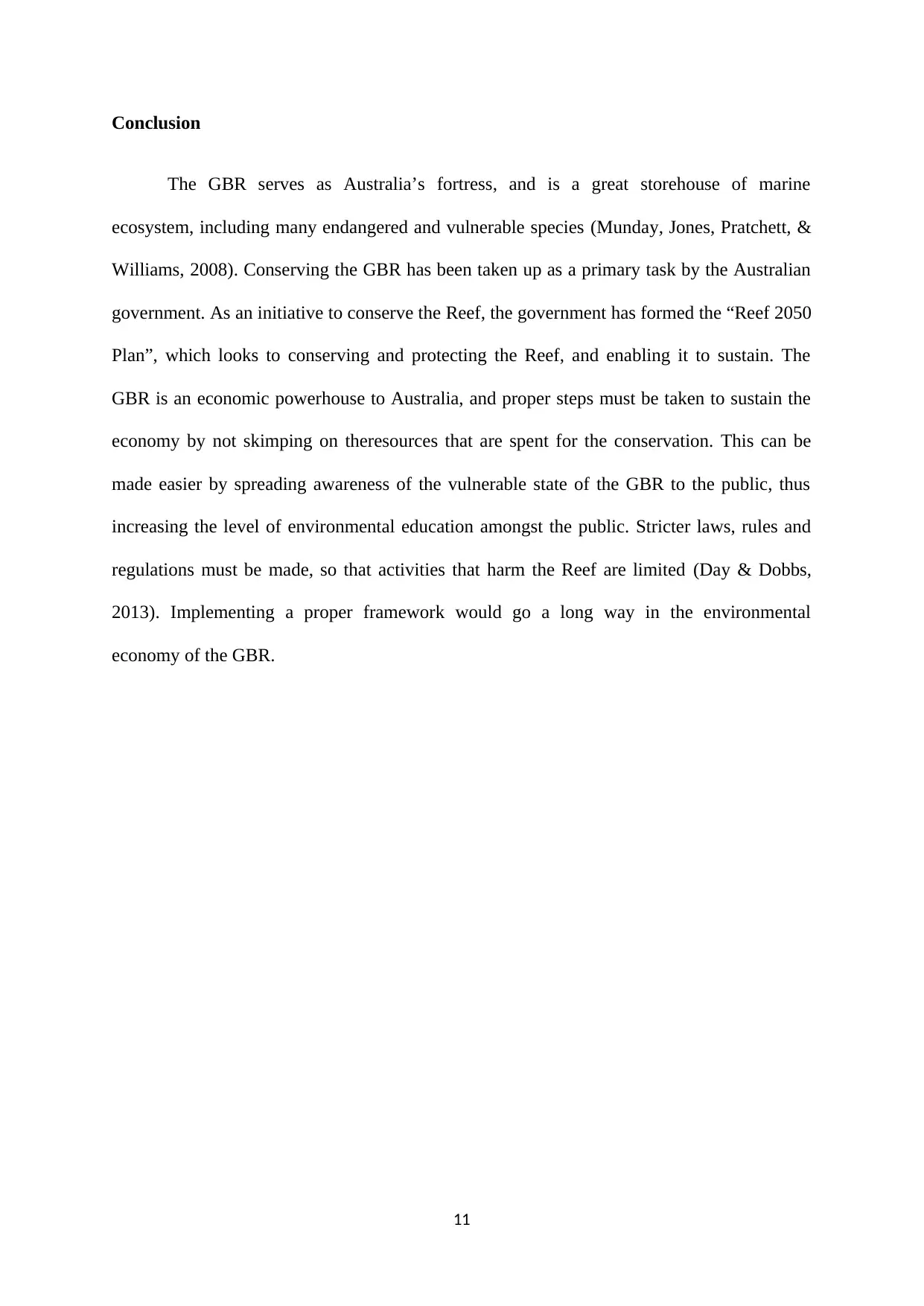
Conclusion
The GBR serves as Australia’s fortress, and is a great storehouse of marine
ecosystem, including many endangered and vulnerable species (Munday, Jones, Pratchett, &
Williams, 2008). Conserving the GBR has been taken up as a primary task by the Australian
government. As an initiative to conserve the Reef, the government has formed the “Reef 2050
Plan”, which looks to conserving and protecting the Reef, and enabling it to sustain. The
GBR is an economic powerhouse to Australia, and proper steps must be taken to sustain the
economy by not skimping on theresources that are spent for the conservation. This can be
made easier by spreading awareness of the vulnerable state of the GBR to the public, thus
increasing the level of environmental education amongst the public. Stricter laws, rules and
regulations must be made, so that activities that harm the Reef are limited (Day & Dobbs,
2013). Implementing a proper framework would go a long way in the environmental
economy of the GBR.
11
The GBR serves as Australia’s fortress, and is a great storehouse of marine
ecosystem, including many endangered and vulnerable species (Munday, Jones, Pratchett, &
Williams, 2008). Conserving the GBR has been taken up as a primary task by the Australian
government. As an initiative to conserve the Reef, the government has formed the “Reef 2050
Plan”, which looks to conserving and protecting the Reef, and enabling it to sustain. The
GBR is an economic powerhouse to Australia, and proper steps must be taken to sustain the
economy by not skimping on theresources that are spent for the conservation. This can be
made easier by spreading awareness of the vulnerable state of the GBR to the public, thus
increasing the level of environmental education amongst the public. Stricter laws, rules and
regulations must be made, so that activities that harm the Reef are limited (Day & Dobbs,
2013). Implementing a proper framework would go a long way in the environmental
economy of the GBR.
11
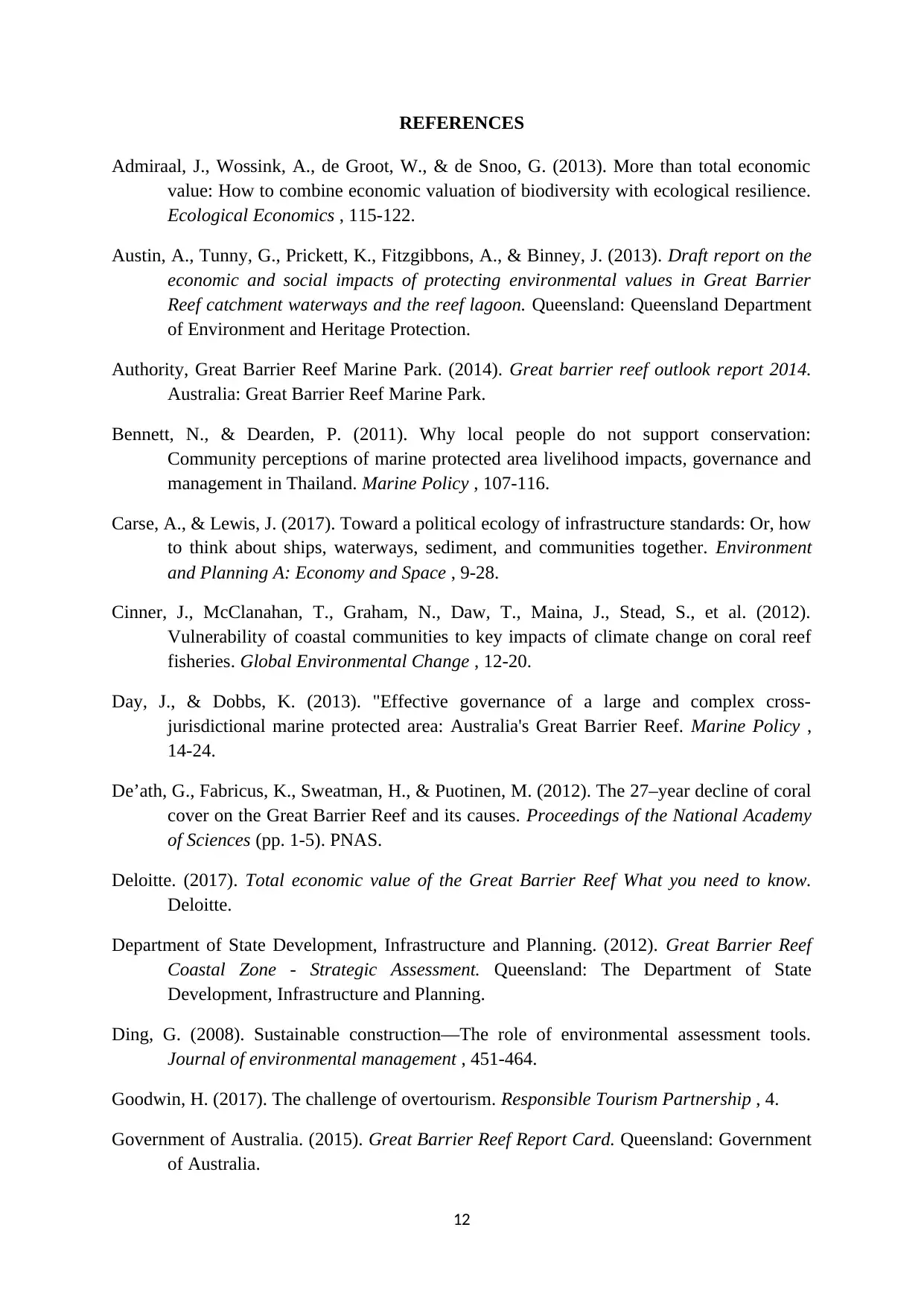
REFERENCES
Admiraal, J., Wossink, A., de Groot, W., & de Snoo, G. (2013). More than total economic
value: How to combine economic valuation of biodiversity with ecological resilience.
Ecological Economics , 115-122.
Austin, A., Tunny, G., Prickett, K., Fitzgibbons, A., & Binney, J. (2013). Draft report on the
economic and social impacts of protecting environmental values in Great Barrier
Reef catchment waterways and the reef lagoon. Queensland: Queensland Department
of Environment and Heritage Protection.
Authority, Great Barrier Reef Marine Park. (2014). Great barrier reef outlook report 2014.
Australia: Great Barrier Reef Marine Park.
Bennett, N., & Dearden, P. (2011). Why local people do not support conservation:
Community perceptions of marine protected area livelihood impacts, governance and
management in Thailand. Marine Policy , 107-116.
Carse, A., & Lewis, J. (2017). Toward a political ecology of infrastructure standards: Or, how
to think about ships, waterways, sediment, and communities together. Environment
and Planning A: Economy and Space , 9-28.
Cinner, J., McClanahan, T., Graham, N., Daw, T., Maina, J., Stead, S., et al. (2012).
Vulnerability of coastal communities to key impacts of climate change on coral reef
fisheries. Global Environmental Change , 12-20.
Day, J., & Dobbs, K. (2013). "Effective governance of a large and complex cross-
jurisdictional marine protected area: Australia's Great Barrier Reef. Marine Policy ,
14-24.
De’ath, G., Fabricus, K., Sweatman, H., & Puotinen, M. (2012). The 27–year decline of coral
cover on the Great Barrier Reef and its causes. Proceedings of the National Academy
of Sciences (pp. 1-5). PNAS.
Deloitte. (2017). Total economic value of the Great Barrier Reef What you need to know.
Deloitte.
Department of State Development, Infrastructure and Planning. (2012). Great Barrier Reef
Coastal Zone - Strategic Assessment. Queensland: The Department of State
Development, Infrastructure and Planning.
Ding, G. (2008). Sustainable construction—The role of environmental assessment tools.
Journal of environmental management , 451-464.
Goodwin, H. (2017). The challenge of overtourism. Responsible Tourism Partnership , 4.
Government of Australia. (2015). Great Barrier Reef Report Card. Queensland: Government
of Australia.
12
Admiraal, J., Wossink, A., de Groot, W., & de Snoo, G. (2013). More than total economic
value: How to combine economic valuation of biodiversity with ecological resilience.
Ecological Economics , 115-122.
Austin, A., Tunny, G., Prickett, K., Fitzgibbons, A., & Binney, J. (2013). Draft report on the
economic and social impacts of protecting environmental values in Great Barrier
Reef catchment waterways and the reef lagoon. Queensland: Queensland Department
of Environment and Heritage Protection.
Authority, Great Barrier Reef Marine Park. (2014). Great barrier reef outlook report 2014.
Australia: Great Barrier Reef Marine Park.
Bennett, N., & Dearden, P. (2011). Why local people do not support conservation:
Community perceptions of marine protected area livelihood impacts, governance and
management in Thailand. Marine Policy , 107-116.
Carse, A., & Lewis, J. (2017). Toward a political ecology of infrastructure standards: Or, how
to think about ships, waterways, sediment, and communities together. Environment
and Planning A: Economy and Space , 9-28.
Cinner, J., McClanahan, T., Graham, N., Daw, T., Maina, J., Stead, S., et al. (2012).
Vulnerability of coastal communities to key impacts of climate change on coral reef
fisheries. Global Environmental Change , 12-20.
Day, J., & Dobbs, K. (2013). "Effective governance of a large and complex cross-
jurisdictional marine protected area: Australia's Great Barrier Reef. Marine Policy ,
14-24.
De’ath, G., Fabricus, K., Sweatman, H., & Puotinen, M. (2012). The 27–year decline of coral
cover on the Great Barrier Reef and its causes. Proceedings of the National Academy
of Sciences (pp. 1-5). PNAS.
Deloitte. (2017). Total economic value of the Great Barrier Reef What you need to know.
Deloitte.
Department of State Development, Infrastructure and Planning. (2012). Great Barrier Reef
Coastal Zone - Strategic Assessment. Queensland: The Department of State
Development, Infrastructure and Planning.
Ding, G. (2008). Sustainable construction—The role of environmental assessment tools.
Journal of environmental management , 451-464.
Goodwin, H. (2017). The challenge of overtourism. Responsible Tourism Partnership , 4.
Government of Australia. (2015). Great Barrier Reef Report Card. Queensland: Government
of Australia.
12

Grech, A., Bos, M., Brodie, J., Coles, R., Dale, A., Gilbert, R., et al. (2013). Guiding
principles for the improved governance of port and shipping impacts in the Great
Barrier Reef. Marine pollution bulletin , 8-20.
Hammill, B., Andersen, C., Johnson, C., Henry, N., Bennett, J., Scoullar, R., et al. (2015).
The Great Barrier Reef Waterscience Taskforce. Queensland: Department of
Environment and Heritage Protection.
Hughes, R., Hughes, D., & Smith, I. (2014). Limits to understanding and managing outbreaks
of crown-of-thorns starfish (Acanthaster spp.). Oceanography and Marine Biology:
An Annual Review , 133-200.
Kennedy, E., Perry, C., Halloran, P., Iglesias-Prieto, R., Schönberg, C., Wisshak, M., et al.
(2013). Avoiding coral reef functional collapse requires local and global action.
Current Biology , 912-918.
Lee, H., Ting, K., Chang, Y., Lee, M., & Liu, W. (2016). Trans-Disciplinary Education for
Sustainable Marine and Coastal Management: A Case Study in Taiwan. Sustainability
, 1-14.
Lesslie, R., & Hill, M. (2008). The Application of a Simple Spatial Multi-Criteria Analysis
Shell to Natural Resource Management Decision Making. Australian Government
Bureau.
Lewis, S., Brodie, J., Bainbridge, Z., Rohde, K., Davis, A., Masters, B., et al. (2009).
Herbicides: a new threat to the Great Barrier Reef. Environmental Pollution , 2470-
2484.
Munday, P., Jones, G., Pratchett, M., & Williams, A. (2008). Climate change and the future
for coral reef fishes. Fish and Fisheries , 261-285.
Omer, A. (2008). Energy, environment and sustainable development. Renewable and
sustainable energy reviews , 2265-2300.
Wolanski, E. (2018). Physical oceanographic processes of the Great Barrier Reef. In E.
Wolanski, Physical oceanographic processes of the Great Barrier Reef (p. 163).
Taylor and Francis.
Wooldridge, S. (2009). Water quality and coral bleaching thresholds: Formalising the linkage
for the inshore reefs of the Great Barrier Reef, Australia. Marine Pollution Bulletin ,
745-751.
13
principles for the improved governance of port and shipping impacts in the Great
Barrier Reef. Marine pollution bulletin , 8-20.
Hammill, B., Andersen, C., Johnson, C., Henry, N., Bennett, J., Scoullar, R., et al. (2015).
The Great Barrier Reef Waterscience Taskforce. Queensland: Department of
Environment and Heritage Protection.
Hughes, R., Hughes, D., & Smith, I. (2014). Limits to understanding and managing outbreaks
of crown-of-thorns starfish (Acanthaster spp.). Oceanography and Marine Biology:
An Annual Review , 133-200.
Kennedy, E., Perry, C., Halloran, P., Iglesias-Prieto, R., Schönberg, C., Wisshak, M., et al.
(2013). Avoiding coral reef functional collapse requires local and global action.
Current Biology , 912-918.
Lee, H., Ting, K., Chang, Y., Lee, M., & Liu, W. (2016). Trans-Disciplinary Education for
Sustainable Marine and Coastal Management: A Case Study in Taiwan. Sustainability
, 1-14.
Lesslie, R., & Hill, M. (2008). The Application of a Simple Spatial Multi-Criteria Analysis
Shell to Natural Resource Management Decision Making. Australian Government
Bureau.
Lewis, S., Brodie, J., Bainbridge, Z., Rohde, K., Davis, A., Masters, B., et al. (2009).
Herbicides: a new threat to the Great Barrier Reef. Environmental Pollution , 2470-
2484.
Munday, P., Jones, G., Pratchett, M., & Williams, A. (2008). Climate change and the future
for coral reef fishes. Fish and Fisheries , 261-285.
Omer, A. (2008). Energy, environment and sustainable development. Renewable and
sustainable energy reviews , 2265-2300.
Wolanski, E. (2018). Physical oceanographic processes of the Great Barrier Reef. In E.
Wolanski, Physical oceanographic processes of the Great Barrier Reef (p. 163).
Taylor and Francis.
Wooldridge, S. (2009). Water quality and coral bleaching thresholds: Formalising the linkage
for the inshore reefs of the Great Barrier Reef, Australia. Marine Pollution Bulletin ,
745-751.
13
1 out of 13
Related Documents
Your All-in-One AI-Powered Toolkit for Academic Success.
+13062052269
info@desklib.com
Available 24*7 on WhatsApp / Email
![[object Object]](/_next/static/media/star-bottom.7253800d.svg)
Unlock your academic potential
© 2024 | Zucol Services PVT LTD | All rights reserved.





